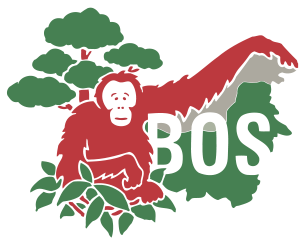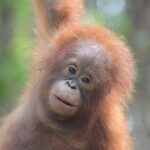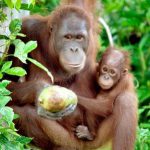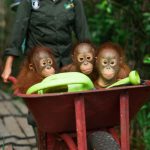Newest rescue is an old face
When orangutans lose their habitat through deforestation, they have to look for food elsewhere. This can cause problems if an orangutan enters a residential area, as happened on 6 June this year. That day, the East Kalimantan Natural Resources Conservation Agency (BKSDA) received a report regarding a male orangutan in Loesan Village. Therefore, the BKSDA’s wildlife rescue squad teamed up with the BOS Foundation and rushed to the village to rescue the orangutan.
Before the mission, news about this orangutan had spread widely on social media. A video featured a resident of Loesan village feeding an adult orangutan with bananas, jackfruit, and canned milk – a rather odd scenario, as orangutans usually avoid direct contact with people.
Furthermore, wild animals should not be fed human food, which is vastly different from their natural food sources. Hence we needed to rescue the orangutan as soon as possible.
When the team members arrived at the village, they couldn’t find the orangutan anywhere. The residents told them that the male had returned to the forest. It was not until 10 June that the team spotted him again.

Welcome back, Uli, after over 20 years!
Assisted by Muhtadin Wahyu, a veterinarian from the Samboja Lestari Orangutan Rehabilitation Centre, they prepared the required anaesthesia and managed to catch the orangutan.
From a brief check, Muhtadin found that the male had a deformed left index finger and a subcutaneously implanted microchip. A dental examination revealed that he was approximately 24 years old.
After arriving at our Samboja Lestari centre, the team placed him in Socialisation Cage C, which we use as a quarantine enclosure for newly arrived orangutans.
A few days later, after we assessed that he was in a stable condition, the veterinary team conducted a thorough examination to obtain more data. They performed nasal and oropharynx swab tests, a rectal swab, X-rays, a dental examination, and they took samples of his blood, sputum, hair, DNA, and fingerprints. In addition, the vets administered deworming medication. All tests and samples taken indicated that the orangutan was in good health.

Uli during his examination.
Particularly interesting was the analysis of the microchip underneath his skin. The orangutan must have undergone rehabilitation at some point in the past. We read the microchip by using a special scanner and then checked our inventory data.
To our surprise, the orangutan turned out to be Uli! He was rescued from Palangka Raya, Central Kalimantan, and taken to Wanariset – our old orangutan rehabilitation centre in East Kalimantan – in February 1998. Our data also showed that Uli was released to the wild at a very young age, in September 1999, in the Meratus Mountain Protection Forest.
We are so excited that Uli survived independently of humans for over 20 years!
Now, he will undergo a quarantine period before we can hopefully transfer him to a pre-release island and eventually back to the rainforest – far away from human settlements.




